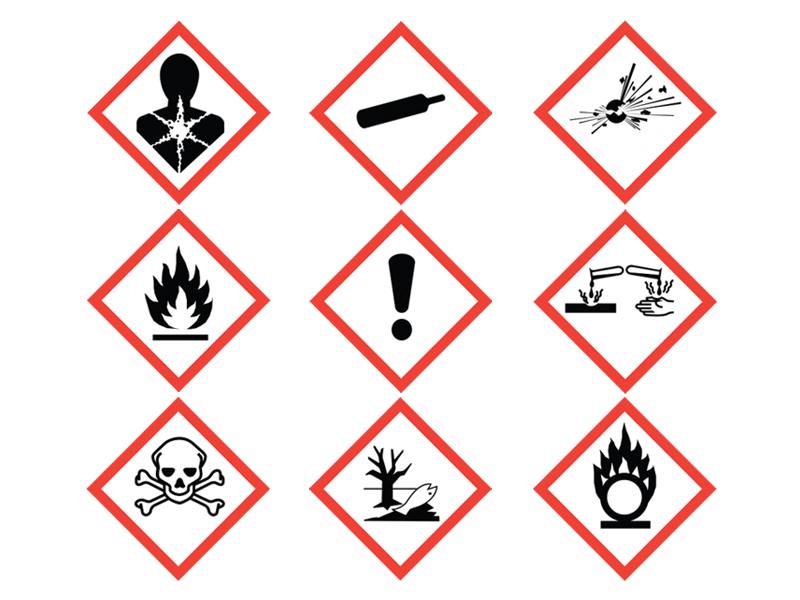While using chemical storage cabinets can vastly improve the safety of your workplace, choosing the correct signage for your storage unit is also an highly important consideration. Having the correct signage for your chemical storage cabinets is not only vital for employee safety but it is also a requirement under the Health and Safety (Safety Signs and Signals) Regulations 1996.
The Regulations require employers to provide the appropriate safety signage in high risk areas of the facility. To help you understand the proper signage to use for chemical storage, we’ve compiled a guide on the labels and warning symbols that help increase chemical safety in the workplace.
1. Warning Labels
Every chemical cabinet in your workplace should have a visible warning label declaring it contains volatile substances. These labels must depict the specific warning relevant to the chemical. (i.e. the label with a flame used to distinguish flammable chemicals)
While it may seem unnecessary to include all of the warning labels relevant to the stored chemical, it is highly important in terms of employee safety and regulatory compliance. The labels below are the most recognised warning signs and will alert even those who are unfamiliar with chemical safety measures to be cautious around the cabinets.
2. Chemical Classification
Each cabinet should have signage declaring the classification of the chemicals within. For example, the labels should affirm if the chemicals inside are flammable, corrosive, oxidizing, toxic or explosive. This is highly important as a variety of chemicals are stored at different temperatures and can become highly volatile when stored improperly.
Additionally, if the cabinet has multiple segregated sections for different chemical groups, this needs to be clearly depicted on the signage to avoid a storage mix up. As a matter of best practice, the separate areas should be labelled on the interior of the chemical cabinet, as this is easier to view when moving the substances.
3. Material Safety Data Sheets
While safety data sheets are only a legal requirement if you are transporting or supplying chemicals to others, they are a helpful resource which can be heavily utilised in the workplace. Material safety data sheets are helpful to people working with chemicals who may be unfamiliar with best practice for chemical safety. They provide workers with information such as potential dangers or measures they should take when handling hazardous chemicals.
It is recommended to display the MSDS on the chemical cabinet or an equally visible place, so all workers can familiarise themselves with the contents. This will significantly improve the chemical safety practices in your facility and reduce the risk from chemical accidents due to human error.
4. Maximum Storage Weight
Appropriate signage that clearly states the maximum volume of chemicals or maximum weight to be stored within each storage unit is necessary. Under duress from excessive weight, chemical cabinets will buckle and collapse.
Neglecting to include storage volume or weight signage in chemical cabinets can results in major workplace accidents and chemical spills. Maximum storage weight signs will not only decrease the risk of chemical accidents, but also ensure compliance with strict H&S regulations.
5. Not for Consumption
This may seem far too obvious a label to include, but many chemicals that require lower temperatures, such as cryogenics, are kept in refrigerated units. “Not for consumption” warning labels prevent workers, who may not be knowledgeable about chemical safety, against placing food stuffs within the same refrigerated units. This removes the potential of cross contamination, thus improving the safety of your employees.
6. Directions of Use
Some businesses choose to assure the safety of their workers by including storage instructions in the signage. The most commonly used is a call to clearly label and tightly close drums, as these are responsible for a large amount of chemical incidents.
However, customized exterior chemical cabinet signage clearly stating directions of use for chemicals stored within is also available, depending on your own storage needs.
Safely Storing Chemicals
The number one cause of chemical accidents in the workplace is lack of education or understanding around safely handling hazardous chemicals. Implementing the 6 best practices outlined above will help to improve workplace safety and reduce the risk of chemical accidents due to human error.
If you’d like to find out more about chemical storage, feel free to get in touch with our team of experts. Alternatively, if you’d like to discover more about best practices for storing chemicals in the workplace and ensuring chemical safety, browse our previous blog posts.
